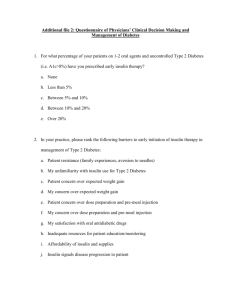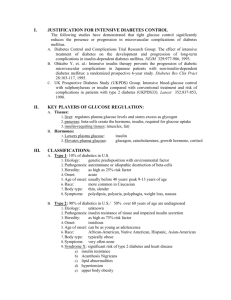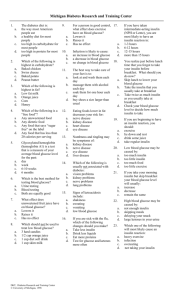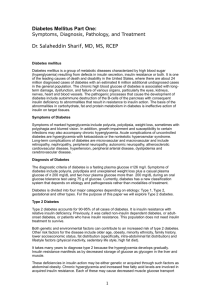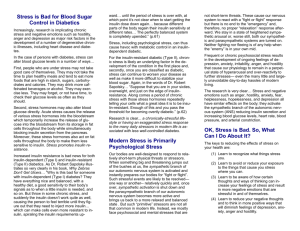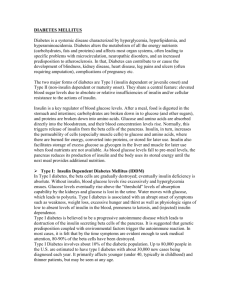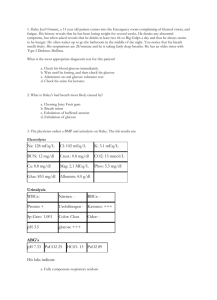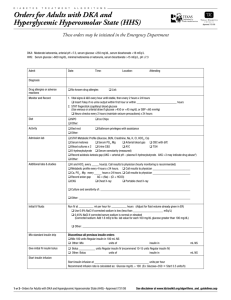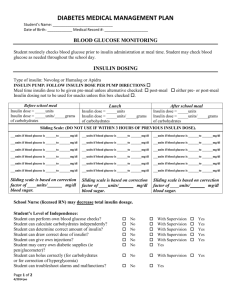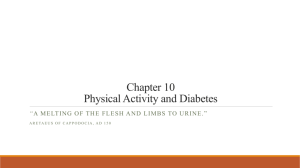Exercise Prescription
advertisement
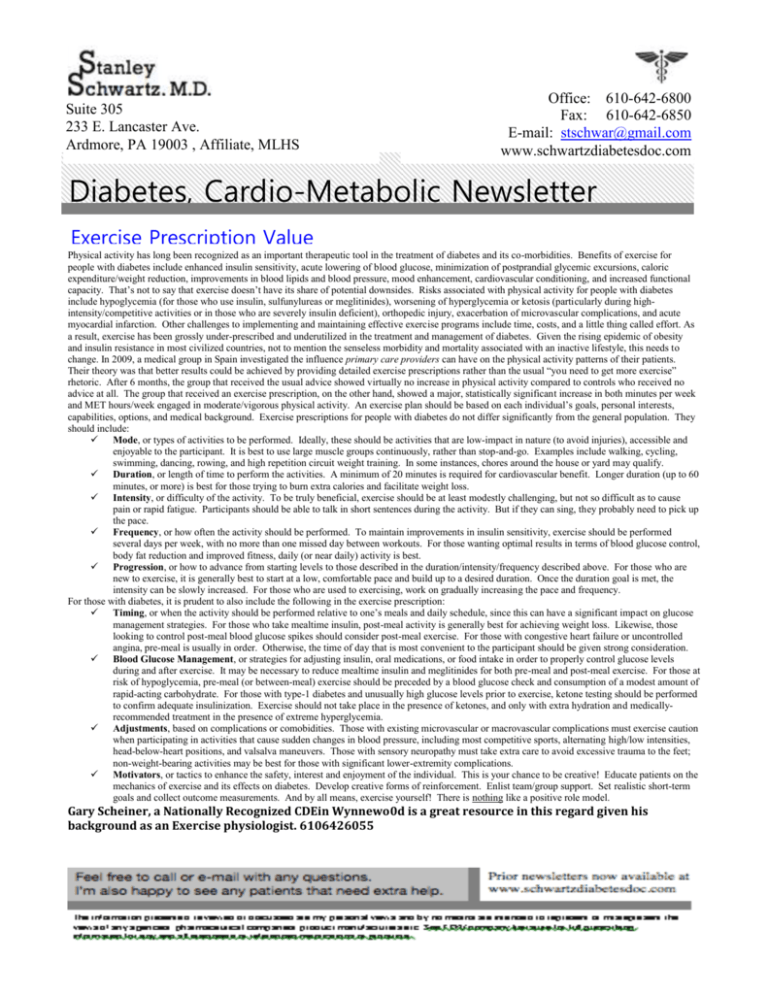
Suite 305 233 E. Lancaster Ave. Ardmore, PA 19003 , Affiliate, MLHS Office: 610-642-6800 Fax: 610-642-6850 E-mail: stschwar@gmail.com www.schwartzdiabetesdoc.com Diabetes, Cardio-Metabolic Newsletter Exercise Prescription Value Physical activity has long been recognized as an important therapeutic tool in the treatment of diabetes and its co-morbidities. Benefits of exercise for people with diabetes include enhanced insulin sensitivity, acute lowering of blood glucose, minimization of postprandial glycemic excursions, caloric expenditure/weight reduction, improvements in blood lipids and blood pressure, mood enhancement, cardiovascular conditioning, and increased functional capacity. That’s not to say that exercise doesn’t have its share of potential downsides. Risks associated with physical activity for people with diabetes include hypoglycemia (for those who use insulin, sulfunylureas or meglitinides), worsening of hyperglycemia or ketosis (particularly during highintensity/competitive activities or in those who are severely insulin deficient), orthopedic injury, exacerbation of microvascular complications, and acute myocardial infarction. Other challenges to implementing and maintaining effective exercise programs include time, costs, and a little thing called effort. As a result, exercise has been grossly under-prescribed and underutilized in the treatment and management of diabetes. Given the rising epidemic of obesity and insulin resistance in most civilized countries, not to mention the senseless morbidity and mortality associated with an inactive lifestyle, this needs to change. In 2009, a medical group in Spain investigated the influence primary care providers can have on the physical activity patterns of their patients. Their theory was that better results could be achieved by providing detailed exercise prescriptions rather than the usual “you need to get more exercise” rhetoric. After 6 months, the group that received the usual advice showed virtually no increase in physical activity compared to controls who received no advice at all. The group that received an exercise prescription, on the other hand, showed a major, statistically significant increase in both minutes per week and MET hours/week engaged in moderate/vigorous physical activity. An exercise plan should be based on each individual’s goals, personal interests, capabilities, options, and medical background. Exercise prescriptions for people with diabetes do not differ significantly from the general population. They should include: Mode, or types of activities to be performed. Ideally, these should be activities that are low-impact in nature (to avoid injuries), accessible and enjoyable to the participant. It is best to use large muscle groups continuously, rather than stop-and-go. Examples include walking, cycling, swimming, dancing, rowing, and high repetition circuit weight training. In some instances, chores around the house or yard may qualify. Duration, or length of time to perform the activities. A minimum of 20 minutes is required for cardiovascular benefit. Longer duration (up to 60 minutes, or more) is best for those trying to burn extra calories and facilitate weight loss. Intensity, or difficulty of the activity. To be truly beneficial, exercise should be at least modestly challenging, but not so difficult as to cause pain or rapid fatigue. Participants should be able to talk in short sentences during the activity. But if they can sing, they probably need to pick up the pace. Frequency, or how often the activity should be performed. To maintain improvements in insulin sensitivity, exercise should be performed several days per week, with no more than one missed day between workouts. For those wanting optimal results in terms of blood glucose control, body fat reduction and improved fitness, daily (or near daily) activity is best. Progression, or how to advance from starting levels to those described in the duration/intensity/frequency described above. For those who are new to exercise, it is generally best to start at a low, comfortable pace and build up to a desired duration. Once the duration goal is met, the intensity can be slowly increased. For those who are used to exercising, work on gradually increasing the pace and frequency. For those with diabetes, it is prudent to also include the following in the exercise prescription: Timing, or when the activity should be performed relative to one’s meals and daily schedule, since this can have a significant impact on glucose management strategies. For those who take mealtime insulin, post-meal activity is generally best for achieving weight loss. Likewise, those looking to control post-meal blood glucose spikes should consider post-meal exercise. For those with congestive heart failure or uncontrolled angina, pre-meal is usually in order. Otherwise, the time of day that is most convenient to the participant should be given strong consideration. Blood Glucose Management, or strategies for adjusting insulin, oral medications, or food intake in order to properly control glucose levels during and after exercise. It may be necessary to reduce mealtime insulin and meglitinides for both pre-meal and post-meal exercise. For those at risk of hypoglycemia, pre-meal (or between-meal) exercise should be preceded by a blood glucose check and consumption of a modest amount of rapid-acting carbohydrate. For those with type-1 diabetes and unusually high glucose levels prior to exercise, ketone testing should be performed to confirm adequate insulinization. Exercise should not take place in the presence of ketones, and only with extra hydration and medicallyrecommended treatment in the presence of extreme hyperglycemia. Adjustments, based on complications or comobidities. Those with existing microvascular or macrovascular complications must exercise caution when participating in activities that cause sudden changes in blood pressure, including most competitive sports, alternating high/low intensities, head-below-heart positions, and valsalva maneuvers. Those with sensory neuropathy must take extra care to avoid excessive trauma to the feet; non-weight-bearing activities may be best for those with significant lower-extremity complications. Motivators, or tactics to enhance the safety, interest and enjoyment of the individual. This is your chance to be creative! Educate patients on the mechanics of exercise and its effects on diabetes. Develop creative forms of reinforcement. Enlist team/group support. Set realistic short-term goals and collect outcome measurements. And by all means, exercise yourself! There is nothing like a positive role model. 2/9/15 Gary Scheiner, a Nationally Recognized CDEin Wynnewo0d is a great resource in this regard given his background as an Exercise physiologist. 6106426055








